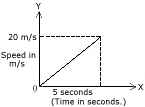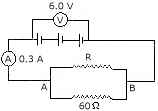(Physics) ICSE Class X Important Questions : Physics (2006)
Disclaimer: This website is NOT associated with CBSE, for official website of CBSE visit - www.cbse.gov.in
Paper : ICSE Class X Important Questions : Physics (2006)
General Instructions
- Section I is compulsory. Attempt any four questions from Section II.
- The intended marks for questions or parts of questions are given in brackets.
SECTION I (40 Marks)
Attempt all questions from this Section
Question 1
(a) Mention any two differences between the mass and weight of a body. [2]
(b) State the amount of work done by an object when it moves in a circular path for one complete rotation. Give a reason to justify your answer. [2]
(c) A uniform metre scale is kept in equilibrium when supported at the 60 cm mark and a mass M is suspended from the 90 cm mark as shown in the

figure. State with reasons, whether the weight of the scale is greater than, less than or equal to the weight of mass M. [2]
(d) Draw a graph showing the relationship between acceleration and mass for a constant force. [2]
(e) The speed-time graph of a moving car is as shown in the figure below:-

Calculate :- (i) the distance covered by the car in 5 seconds.
(ii) the acceleration of the car.
Question 2
(a) Will the pressure exerted by water on a diver at a certain depth in the sea, be the same, more, or less than the pressure exerted on him in a river at the same depth? Justify your answer. [2]
(b) Mention one similarity and one difference between the lens of a photographic camera and that of the human eye. [2]
(c) An object is placed in front of a convex lens such that the image formed has the same size as that of the object. Draw a ray diagram to illustrate this. [2]
(d) Give two reasons as to why copper is preferred over other metals for making calorimeters. [2]
Calculate the height through which a body of mass 0.5 kg should be lifted if the energy spent for doing so is 1.0 joule. (g = l0 ms-2). [2]
Question 3
(a) Explain why musical instruments like the guitar are provided with a hollow box. [2]
(b) A wire of uniform thickness with a resistance of 27 Ω is cut into three equal pieces and they are joined in parallel. Find the resistance of the parallel combination. [2]
(c) Draw a labelled diagram of a three-pin socket. [2]
(d) A room has window panes made of a special glass which can reflect green light, transmit red light, scatter blue light and absorb all the other colours of light. The room is illuminated with white light from the inside. What colour will the window pane appear when seen from:
- inside the room
- outside the room ? [2]
(e) What is Newton's colour disc ? What does the Newton's colour disc experiment establish about the nature of white light ?
Question 4
(a) State two advantages of an electromagnet over a permanent magnet.[2]
(b) Calculate the amount of heat released when 5.0 g of water
at 200C is changed into ice at 00C.
(Specific heat capacity of water = 4.2 J/g0C
Specific latent heat of fusion of ice = 336 J/g). [2]
(c) Mention two factors on which the resistance of a wire depends.[2]
(d) A certain radioactive nucleus emits a particle that leaves its mass unchanged but increases its atomic number by one. Identify the particle and write its symbol. [2]
(e) What is a nuclear chain reaction? [2]
SECTION II (40 Marks)
Attempt any four questions from this Section.
Question 5
(a) Show that for the free fall of a body, the sum of the mechanical energy at any point in its path is constant. [4]
(b) Name the type of single pulley that can act as a force multiplier. Draw a labelled diagram of the above named pulley. [3]
(c) A pulley system has a velocity ratio of 4 and an efficiency of 90%.
Calculate :-
- the mechanical advantage of the system.
- the effort required to raise a load of 300 N by the system.
Question 6 [4]
(a) A wooden cylinder of length 40.0 cm and area of cross section 5.0 cm2, floats in a liquid of density 0.72 g cm-3 such that 4.0 cm of the cylinder is above water.
Calculate:
- the density of the wood
- the mass of the wood.[3]
(b) (i) What is the approximate numerical value of the normal atmospheric pressure in units of Pascals?
(ii) Why is the barometric pressure of a place expressed in centimetres of mercury rather than in Pascals? [3]
(c) Define Newton, the S.I. unit of force. State its relationship with the C.G.S. unit of force.[4]
Question 7
(a) PQ and PR are two light rays emerging from the object P as shown in the figure below:-

- What is the special name given in the angle incidence (∠PQN) of ray PQ?
- Copy the ray diagram and complete it to show the position of the image of the object P when seen obliquely from above.
- Name the phenomenon that occurs if the angle of incidence ∠PQN is increased still further .[3]
(b) When a tuning fork, struck by a rubber pad, is held over a length of air column in a tube, it produces a loud sound for a fixed length of the air column.
- Name the above phenomenon.
- How does the frequency of the loud sound compare with that of the tuning fork?
- State the unit for measuring loudness[3].
(c) Give one use each of the electromagnetic radiations given below:
(i) Microwaves
(ii) Ultraviolet radiation
(iii) Infrared radiation .[2]
Question 8
(a) A piece of iron of mass 2.0 kg has a thermal capacity of 966 J/0C.
(i) How much heat is needed to warm it by 150C?
(ii) What is its specific heat capacity in S.I. units? [3]
(b) (i) Define specific latent heat of vaporization of a substance.
(ii) What is the principle of calorimetry? [3]
(c) Explain why water is used in hot water bottles for fomentation and also as a universal coolant. [4]
Question 9
(a.) In the figure below, the ammeter A reads 0.3 A. Calculate:-

- the total resistance of the circuit.
- the value of R.
- the current flowing through R. [3]
(b) Find the cost of operating an electric toaster for two hours if it draws 8A current on a 110 volt circuit. The cost of electrical energy is Rs. 2.50 per kWh. [3]
(c) (i) What will happen to a compass needle when the compass is placed below a wire and a current is made to flow through the wire? Give a reason to justify your answer.
(ii) What energy conversion takes place during the working of a d.c. motor? [4]
Question 10
(a) (i) Name the material used for making the control rods in a nuclear fission reaction. Why is the material named by you suitable for this purpose?
(ii) State one difference and one similarity between a nuclear bomb and a nuclear reactor.[3]
(b) (i) Define thermionic emission.
(ii) Mention one use of thermionic emission.
(iii) Name a substance which is a good thermionic emitter.[3]
(c) State three properties that are common to and shown by both beta rays and cathode rays.